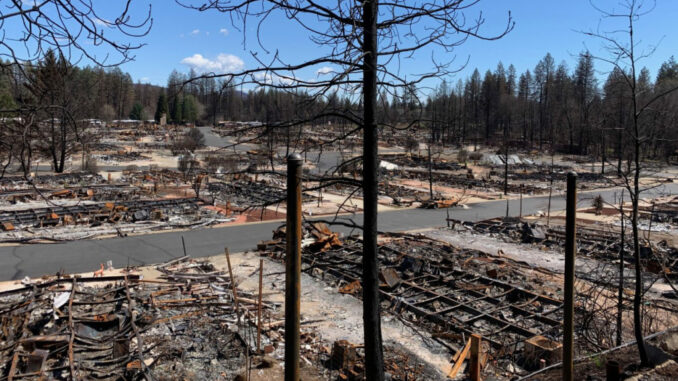
A new analysis from the Colorado State Forest Service shows that just under half of Colorado’s population, about 2.5 million people, lives in the wildland-urban interface. Of these residents, more than 1 million live in areas with moderate to very high risk of wildfire.
“The Colorado Wildfire Risk Assessment is a nation-leading analysis that gives us important information as Colorado and other Western states face the reality of a year-long wildfire season,” said Governor Polis. “This update is a reminder for everyone to keep up with wildfire mitigation efforts to help keep your homes and communities safe.”
This analysis considers the wildland-urban interface (WUI) as the area where human development (roads, buildings and neighborhoods) are built close to or within natural terrain and flammable vegetation and is at risk of wildfire. New data reveal that the WUI in Colorado consists of about 4.5 million acres, or about 45 times the size of the City of Denver, and contains more than 1 million buildings.
“This new analysis demonstrates that wildfire continues to pose a serious risk to large numbers of Coloradans who live or own businesses in the wildland-urban interface. Empowering these residents to reduce this risk is crucial with a warming climate and periods of drought raising the potential for a large, destructive wildfire at any time,” said Matt McCombs, CSFS director and state forester. “Understanding wildfire risk is an important first step to taking action, and we encourage communities, planners, and people who live in the WUI to use this best-in-class model to help them prepare for wildfire.”
This summer, the CSFS released an update to the Colorado Wildfire Risk Assessment (CO-WRA), which provides critical data and analysis about potential impacts of wildfire specific to Colorado.
“Wildfire has had a devastating impact on Coloradans and our communities and we all know that we are one lighting strike or one unattended campfire away from our next megafire in Colorado. Our only choice is to be prepared for this inevitability through fuel reduction, education and outreach, and planning,” said Dan Gibbs, Colorado Department of Natural Resources executive director. “I applaud the work of the Colorado State Forest Service in developing the Colorado Wildfire Risk Assessment. It is an important tool for wildfire prevention professionals and homeowners to determine community and personal wildfire risk and encourage Coloradans to take known effective measures to reduce that risk in the face of future wildfires.”
Using data collected at the end of 2022, the updated version of CO-WRA, first released in 2012, helps community leaders, planners, and interested residents understand their risk of wildfire. This is the first major update since 2018; moving forward, the data will be updated every three years. The online mapping tool is part of the Colorado Forest Atlas, and it demonstrates where forest management actions can achieve the greatest impact to reduce wildfire risk.
“The Colorado Wildfire Risk Assessment is a detailed, data-driven model that depicts available vegetative fuels, potential fire behavior and risk throughout Colorado, in grasslands and forestlands, as well as both urban and rural areas,” said Amanda West Fordham, Ph.D., CSFS associate director, Science and Data Division. “This robust tool can inform community wildfire protection plans to better prepare Coloradans for the dangers of an uncharacteristic wildfire.”
The CO-WRA analysis focuses on the neighborhood to community level, and it does not include data about individual building materials or fires spread from structure to structure. Staff in the Science and Data Division of the CSFS worked with contractor Technosylva to add innovative data analysis to gain as clear and accurate a picture as possible of the conditions across Colorado specific to the state.
“The 2022 CO-WRA update represents an important step forward in terms of characterizing fire behavior and risk across the state to improve mitigating the negative consequences of wildfires. Technosylva has improved the resolution of outputs (20 meters) and used the latest technological and science advances to assess fire risk. It’s worthy to highlight that all the LiDAR available in Colorado was processed to derive continuous surface and crown fuel types. Also, custom fuels were used to better characterize the fire behavior in both WUI and timber areas after proving the low performance of other fuel families in the aforementioned fuel types. Finally, this project provides unprecedented insights and characterization of the building’s defensible space and probability of building loss in case a fire reaches it,” said Adrián Cardil Forradellas, Ph.D., senior researcher, Technosylva.
Learn more about the Colorado Wildfire Risk Assessment and explore the latest data with easy-to-use, interactive maps at coloradforestatlas.org.
Colorado residents can check their own wildfire risk and learn low-cost, practical ways to protect people, pets and property at LiveWildfireReady.org.
Support Northern Colorado Journalism
Show your support for North Forty News by helping us produce more content. It's a kind and simple gesture that will help us continue to bring more content to you.
BONUS - Donors get a link in their receipt to sign up for our once-per-week instant text messaging alert. Get your e-copy of North Forty News the moment it is released!
Click to Donate
